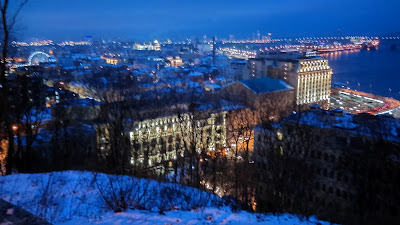It snowed overnight here last night and when I left the hotel before dawn at 6:45 this morning the snowploughs and gritters were finishing their duties and the council staff were starting work on the pavements - ON A SUNDAY - Look and learn Britain!
I was up early to meet my guide and join the tour to Chernobyl. There were 9 of us on today's tour with Gamma Travel (I'll give them a plug because they were very good).
The Chernobyl Nuclear Accident happened on 26 April 1986 and the plant is a two hour drive north from Kyiv near the border with Belarus. There is a 30km excusion zone and a 10km one both of which have been depopulated. The purpose of the 30km zone is to act as a buffer area of restricted open space between the contaminated sector and the outside world. There are still people working on the Chernobyl complex and they stay in hostels in the 30km zone while they are working. 10km is where most of the danger lies.
At the 30km zone check point, our passports are checked and matched with the details on file (Gamma Travel had to apply for permits in advance) and we are given personal monitors on lanyards. These would be worn throughout the day and be handed in at the end so the authorities can log the amount of radiation we were picking up. If it suddenly increased for a large number of people, I'm guessing the tours would be stopped. At this point you can also rent hand held Geiger Counters to use for your own information during the day.

This is what the Chernobyl No 4 nuclear reactor looks like these days. Encased in this stainless steal and concrete sarcophagus to contain the radiation. The reason that Chernobyl was chosen as the site for the nuclear power station is that it was planned as the biggest nuclear power station in the world, producing electricity to export to the west. 12 reactors were planned but only 4 were actually built and switched on, number 5 was under construction and almost finished when the accident happened.
The normal reading for everyday background radiation is 0.1 All the way through the 30km zone the reading on my Geiger Counter stayed at 0.1 or there abouts, however, almost as soon as we passed the check point into the 10km exclusion zone it started to increase and once we were near the nuclear reactor it had reached 0.84 - still safe for us on a short visit but over 8 times normal.
From the reactor we went to Pripyat a few kiometres away. Pripyat was a model Soviet city, purpose built to house workers at the nuclear plant. Those workers were considered to be high up the scale so the housing and facilities afforded them were of a much better quality than was usually available in the Soviet Union. When Pripyat was evacuated the residents were given just 2.5 hours to leave.
The apartment blocks now lie empty and most of the trees in my pictures have grown since the accident.
This is the amusement park in the centre of the city, the dodgems and ferris wheel lie abandoned.

Here my Gieger Counter got up to 1.21 (12 x normal).
 |
| Pripyat's Main Square |
There are hot spots of radiation which the guides point out to those people who have hired Gieger Counters. At one hot spot my unit reached 48.3 (yes the decimal point is in the right place, 483 x normal). No photo I'm afraid because the guide told me to move!
Then it was lunch time. We were taken to a workers canteen where for the tourist groups they serve a traditional Soviet workers meal. Borsch (beetroot soup), a piece of meat (didn't want to ask what) with some mashed potatoes or polenta, a mixed salad (more beetroot - can't stand the stuff), and a piece of dry cake similar to what we would soak in a trifle - Yipee! I sat with three Czech guys who after Kyiv were heading to Minsk in Belarus - impressive!
Final stop on the tour was the Duga Over-the-Horizon Radar. These massive structures were part of the Soviet Cold War early warning system. Elsewhere they have been dismantled but here it is contaminated and therefore is still standing. They caused so much interference with tv and radio signals, causing a tapping noise, they were nicknamed in the west as Russian Woodpeckers
On leaving the 10km exclusion zone we all had to get off the minibus and stand in machines that measured our radiation levels, the bus was also checked. The same thing happened again at the 30km check point.
The whole trip was interesting, thought provoking and fun in equal measure. The most sobering thought was that the danger is completely invisible, you are relying on the Geiger counter to warn you - without that technology you have no way of knowing what is unsafe.
And to round off the day nicely - I am now the proud owner of a fridge magnet that glows in the dark.
































